Puteri Hrobour Marina
Johor, Malaysia
Hi All,
Randal and I are now 100% sure we’ll be home this fall. We leave Singapore September 29th and return to Singapore November 22nd. Sounds like a long time to be home but I already feel panic to get everything done we’ll want to get done. We want to visit family and friends from Roanoke, other parts of VA and those friends up North. We have all those “health” appointments we do annually. It will definitely be good to be away from the tropical weather. We will move the boat to Sebana Cove early in August and most likely leave it there while we are away.
Ru
DoraMac
Tibet # 14 Shigatse
Shigatse is the second largest city in Tibet with a population of about 80,000 making it about the same size as Roanoke County. It is 160 miles southwest of Lhasa and it had taken us all day to cover those 160 miles. We were driving along what is called The Friendship Highway.
“The Friendship Highway is a scenic route on the Tibetan Plateau. It includes the westernmost part of China National Highway 318 from Lhasa west to Lhatse then south to Nepal as well as the southernmost part of China National Highway 219 from Lhatse to Gar in far western Tibet. Friendship Highway begins at Lhasa, capital of Tibet Autonomous Region. It passes near turquoise Yamdrok Lake and through Gyantse to Shigatse, Tibet’s second-largest city and home of the Panchen Lama. Continuing west parallel to the Yarlung Zangbo River/Brahmaputra, it passes Lhatse and forks just beyond at Chapu.
One branch continues west and upriver as China National Highway 219, finally crossing the Brahmaputra/Indus divide near sacred Mount Kailash and Lake Manasarovar, then on to Ali in Gar County.
The other branch (Our route) from Chapu maintains the Hwy 318 route number. It turns southwest and crosses the main Brahmaputra-Ganges divide at Lakpa-La, 5,250m/17,225′. Descending 800 meters onto alluvial plains of the Bum-Chu — also known as the Arun in Nepal — the highway passes Xêgar (New Tingri) and Old Tingri, both gateways to Rongbuk Monastery and the north side of Mount Everest. Continuing southwest, the highway climbs over Lalung-La (5,050m/16,570′) above headwaters of the Matsang Tsangpo (Sun Kosi). This stream as well as Bum-Chu/Arun flow south into Nepal, two of the Seven Koshis joining forces before breaking out of the Himalayan foothills and continuing south to the Ganges. Friendship Highway then descends through Nyalam, then more steeply through a canyon to Zhangmu where Friendship Bridge crosses into Nepal at a mere 1,750m/5,740′ elevation. The extension to Kathmandu is named Arniko Rajmarg.
Scenery along the highway features important cultural monuments, the upper valley of the Yarlung Zangbo (Brahmaputra) River, vast grasslands and meadows on the plateau, and mountain vistas including five of the world’s highest peaks: Everest, Lhotse, Makalu, Cho Oyu and Shishapangma as well as largely unexplored and unclimbed peaks east and west of Lakpa-La reaching about 6,400 meters. Friendship Highway is also important to pilgrims making their way from all corners of Tibet to the spiritual center in Lhasa and to the sacred circuits of Mount Kailash and Lake Manasarovar.
http://en.wikipedia.org/wiki/Friendship_Highway_(Tibet)
I read one blog where a woman said she’d been warned that the scenery would be monotonous but she found the whole route beautiful. That’s how I felt too!
We basically just stopped in Shigatse to spend the night so we didn’t see anything other than the few blocks around our hotel which wasn’t in the newest part of the city. We arrived in time to get our room, lug our stuff up three flights of stairs, and then walk off to dinner.
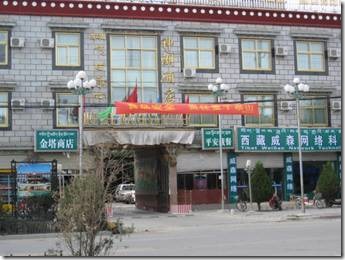
Looks a lot like our concrete block hotel in Lhasa.
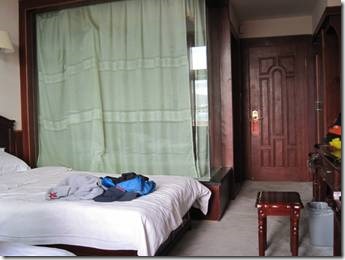
Behind the curtain is the bathroom, odd! When we first went into the room I noticed an unpleasant smell coming from the bathroom. I tried to flush the toilet and it wouldn’t flush. Randal was still back in the lobby checking us in so I walked down the 3 flights of stairs and over to the lobby and told Lobsang our toilet wouldn’t work. He said that the hotel was full so we couldn’t change rooms but someone would be sent to fix the toilet. I walked back to the room and when I got there, someone was checking the toilet in David and Ron’s room next door. Actually she was just spraying air freshener to fix what she thought was the problem with the toilet. I motioned to her to come to our room (she didn’t speak English) and she started to spray. I showed her that the toilet wouldn’t flush so she left to get more help. By then, Randal had struggled his way up the 3 flights to our room and realized that the water to the toilet had been shut off so turned it on. It worked; not so well as David and Ronnie’s but it would do. And the room did have an electric kettle so we could have our early morning tea and coffee. There was no Internet option in the room, but the small business center had a few computers that weren’t very busy though the hotel was actually full of mostly western tourists.
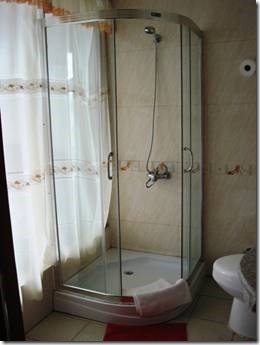
A glass wall separated the bathroom from the rest of the room. The curtain was sort of a lacy see through material. Not sure whose idea that all was. The bathroom and the bedroom had plenty of light so that couldn’t have been the reason. But the water was hot and that really was more important than an odd glass bathroom wall. They also could have left a bit more room between the toilet and the shower stall. (Our next night we had no running water at all and a squat toilet and the night after that the toilet was in the shower, and in Kathmandu there was only hot water after 7:30 am)
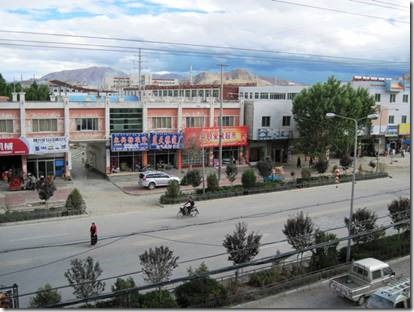
Looking down from our room onto the main road.
The hotel had a dining room, but we thought we’d go out for a walk and find a place that wasn’t so aimed at tourists. We walked several blocks and only found one restaurant that wasn’t just a storefront set with a few tables. (There were more choices, I’m sure if we had walked further, but we were too tired.) We went in and it was not touristy at all: nothing was written in English and no one spoke English. I used my picture book to order broccoli and Randal ordered fried rice. They cooked the entire head of a huge broccoli but we ate most of it.
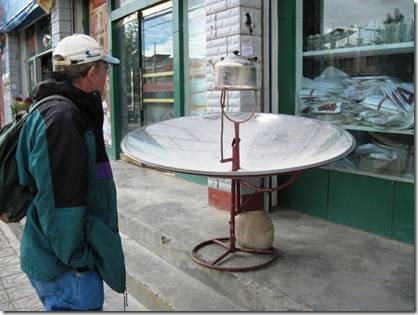
One of the shops along the way sold solar water heaters and we saw them everywhere in Tibet.
“The per capita utilization of electricity in Tibet is far lower than the national average. (National Average here must mean the average in the country of China.) The region lacks coal, and it is therefore impossible to develop thermal power. The existing large and medium-sized hydroelectricity stations only generate enough electricity to satisfy the needs of Tibet’s dense urban population, while farmers and herdsmen scattered in remote mountain areas must manage without. However, with its dry climate, thin air, negligible cloud, and annual 3,000 hours of sunshine, Tibet is especially suitable for developing solar energy.” http://www.tibetinfor.com/tibetzt/question_e/3/038.htm
And this is also pretty interesting…..
Harnessing the Tibetan sun http://web.mit.edu/newsoffice/2008/itw-tibet-tt0604.html
In many villages throughout Tibet, there are two ways to cook a meal. There’s the traditional open fire, fueled by yak dung or the region’s increasingly scarce wood. And then there are solar cookers, concentrating mirrors made of two-inch-thick concrete and covered with a mosaic of small glass mirrors.
The fires produce a lot of smoke, which, especially in the confined quarters of a kitchen, can lead to lung disease. The solar cookers are clean, but so heavy that it takes four people to move one, and they have a poorly engineered focus that sometimes lights fires, cooks food unevenly or even damages metal pots.
When MIT student Scot Frank and Catlin Powers of Wellesley College visited Tibet two years ago, one thing they kept hearing from the villagers was that it would make a big difference to their lives if there was a solar cooker that was lightweight enough to be carried with them when they went off to spend the day tending their fields or their flocks, yet strong enough to stand up to the strong winds that howl across the Tibetan plateau.
A team of students from MIT and from Qinghai Normal University in Tibet’s Amdo region ended up producing exactly that. The lightweight dish they produced, inspired by Tibetan nomadic tents, is made of yak-wool canvas panels, supported by bamboo ribs, and faced with reflective mylar. Easily disassembled and transported by one person, the cooker can then be quickly reassembled in the field and staked down solidly on the ground to resist the wind. In the fall, the students will begin testing their prototype in several villages, and make the design available to local factories for manufacture.”
(You can read the rest of the article at the link. I’m not sure what model is in the photo but it seems to need to be held down by a huge rock.)
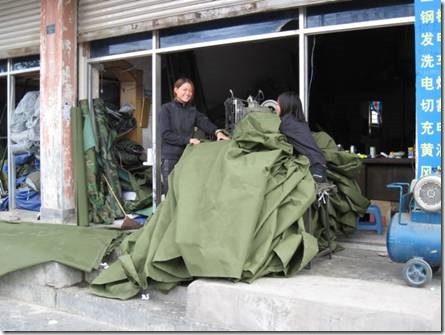
These two women were using a huge sewing machine to sew on this giant piece of heavy material. They laughed at my wanting to take of photo of them at work. They probably think it’s the most normal thing on earth to be working as they do.
Then we walked back to our hotel, up the 3 flights and went to sleep.
The next morning we went to the hotel restaurant for the breakfast buffet. Breakfasts were included as part of the tour. There was great bread again and eggs and peanut butter and it was hard to avoid overeating. I drank about a gallon of tea. The dining room was full and you could hear many different languages. But most people were speaking English.
We loaded up the car and drove off to visit the Tashihunpo Monastery founded by the first Dalai Lama in 1447. While we stayed there, Lobsang went off to get our Everest Passes that we’d been too late to get the day before.

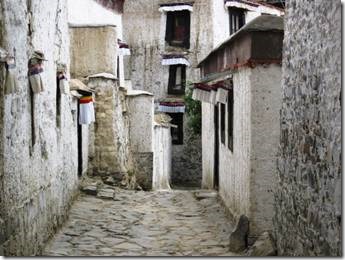
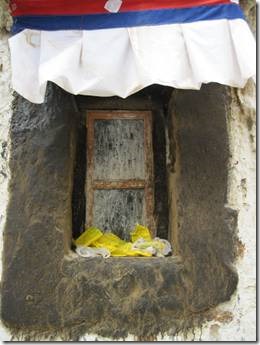
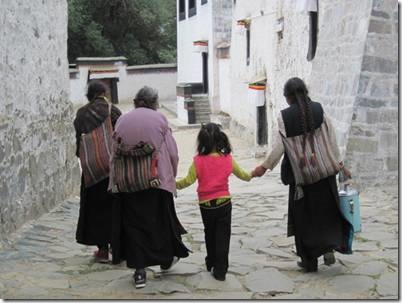
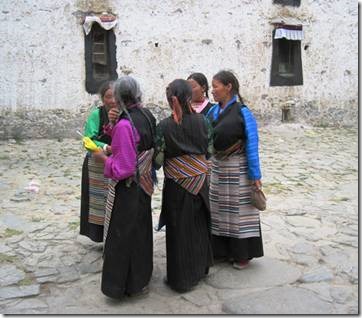

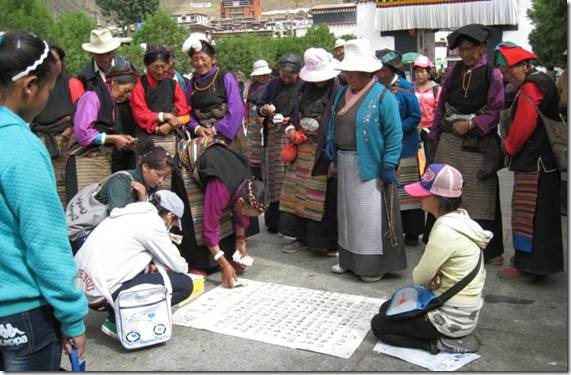
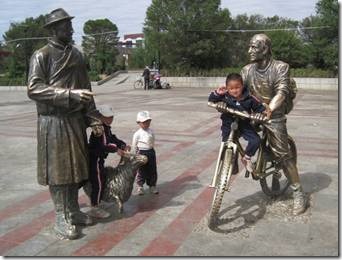
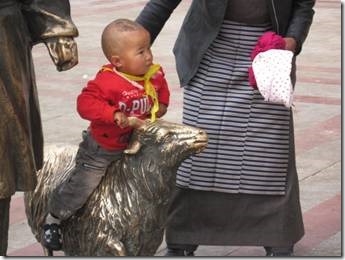
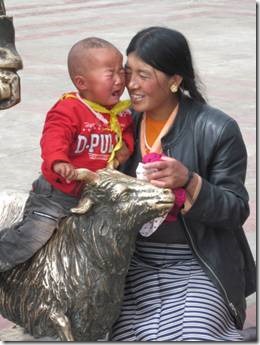
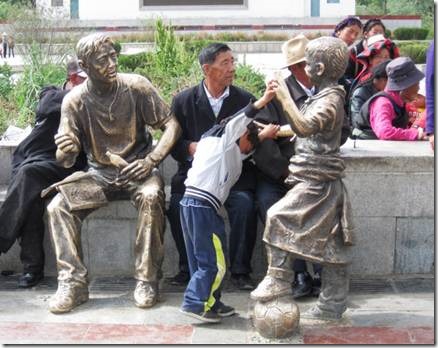
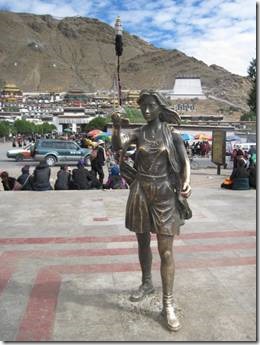
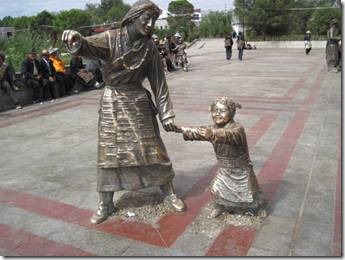
![clip_image001[4] clip_image001[4]](http://www.mydoramac.com/wp-content/uploads/2016/04/clip_image0014_thumb2.jpg)
![clip_image002[4] clip_image002[4]](http://www.mydoramac.com/wp-content/uploads/2016/04/clip_image0024_thumb4.jpg)
![clip_image003[4] clip_image003[4]](http://www.mydoramac.com/wp-content/uploads/2016/04/clip_image0034_thumb2.jpg)
![clip_image004[4] clip_image004[4]](http://www.mydoramac.com/wp-content/uploads/2016/04/clip_image0044_thumb3.jpg)
![clip_image005[4] clip_image005[4]](http://www.mydoramac.com/wp-content/uploads/2016/04/clip_image0054_thumb2.jpg)
![clip_image006[4] clip_image006[4]](http://www.mydoramac.com/wp-content/uploads/2016/04/clip_image0064_thumb2.jpg)
![clip_image007[4] clip_image007[4]](http://www.mydoramac.com/wp-content/uploads/2016/04/clip_image0074_thumb1.jpg)
![clip_image008[4] clip_image008[4]](http://www.mydoramac.com/wp-content/uploads/2016/04/clip_image0084_thumb2.jpg)
![clip_image009[4] clip_image009[4]](http://www.mydoramac.com/wp-content/uploads/2016/04/clip_image0094_thumb1.jpg)
![clip_image010[4] clip_image010[4]](http://www.mydoramac.com/wp-content/uploads/2016/04/clip_image0104_thumb1.jpg)
![clip_image011[4] clip_image011[4]](http://www.mydoramac.com/wp-content/uploads/2016/04/clip_image0114_thumb1.jpg)
![clip_image012[4] clip_image012[4]](http://www.mydoramac.com/wp-content/uploads/2016/04/clip_image0124_thumb1.jpg)
![clip_image013[4] clip_image013[4]](http://www.mydoramac.com/wp-content/uploads/2016/04/clip_image0134_thumb1.jpg)
![clip_image014[4] clip_image014[4]](http://www.mydoramac.com/wp-content/uploads/2016/04/clip_image0144_thumb1.jpg)
![clip_image015[4] clip_image015[4]](http://www.mydoramac.com/wp-content/uploads/2016/04/clip_image0154_thumb1.jpg)
![clip_image016[4] clip_image016[4]](http://www.mydoramac.com/wp-content/uploads/2016/04/clip_image0164_thumb1.jpg)
![clip_image017[4] clip_image017[4]](http://www.mydoramac.com/wp-content/uploads/2016/04/clip_image0174_thumb.jpg)





